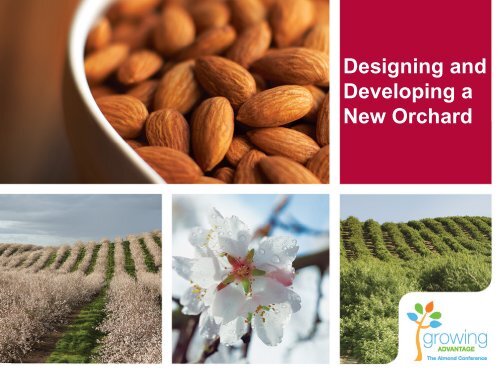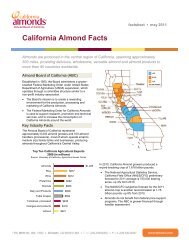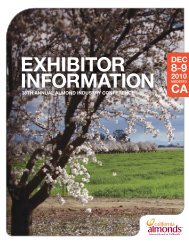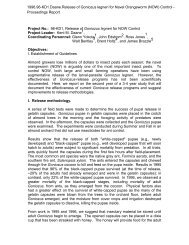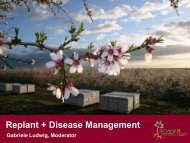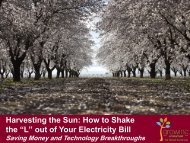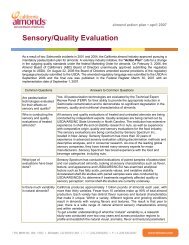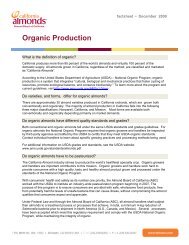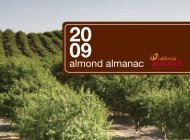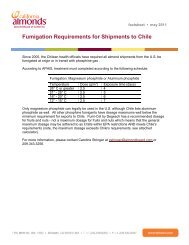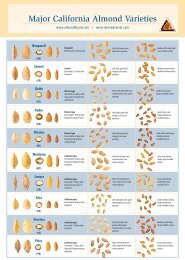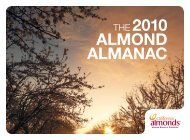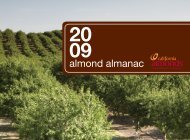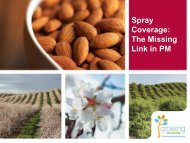Designing and Developing a New Orchard - Almond Board of ...
Designing and Developing a New Orchard - Almond Board of ...
Designing and Developing a New Orchard - Almond Board of ...
Create successful ePaper yourself
Turn your PDF publications into a flip-book with our unique Google optimized e-Paper software.
<strong>Designing</strong> <strong>and</strong><br />
<strong>Developing</strong> a<br />
<strong>New</strong> <strong>Orchard</strong>
<strong>Designing</strong> <strong>and</strong> <strong>Developing</strong><br />
a <strong>New</strong> <strong>Orchard</strong><br />
Bob Curtis<br />
<strong>Almond</strong> <strong>Board</strong> <strong>of</strong> California
<strong>Designing</strong> & <strong>Developing</strong><br />
a <strong>New</strong> <strong>Orchard</strong><br />
• Rootstocks, Varieties,<br />
Tree Arrangement &<br />
Pruning<br />
Roger Duncan<br />
UC Cooperative Extension<br />
Stanislaus County
Work by Bruce Lampinen, UCD
Work by Bruce Lampinen, UCD<br />
Every 1% increase in light<br />
interception = 50 pounds per acre<br />
higher yield potential
Goal: Maximum Light Interception<br />
Use integration <strong>of</strong> appropriate<br />
rootstock, planting density / tree<br />
arrangement & minimal pruning to<br />
achieve maximum light<br />
interception.
Rootstocks:<br />
The Best Offense is a<br />
Good Defense<br />
• Think <strong>of</strong> the<br />
rootstock as your<br />
protection against<br />
premature orchard<br />
decline.
What is the best<br />
rootstock<br />
• Anticipate possible problems with site<br />
• If no specific biological, chemical or physical<br />
soil challenges are present, rootstock choice<br />
may not make much difference as long as<br />
planting density is appropriate.
Nemaguard<br />
• Advantages<br />
•“Immune” to rootknot nematode<br />
•Vigorous rootstock<br />
•Compatible with all almond varieties<br />
•Performs well in s<strong>and</strong>y loam & loam soils<br />
•“Decent” anchorage<br />
•Growers are familiar with it
Nemaguard<br />
• Disadvantages<br />
•Susceptible to:<br />
•Ring & root lesion nematodes<br />
•Bacterial canker<br />
•High soil pH / high lime<br />
•Salt (sodium, chloride, boron)<br />
•Phytophthora / “wet feet”<br />
•Oak root fungus<br />
•Crown gall<br />
•“Heart” rot / wood decay fungi
Specific Challenges…<br />
• Alkaline / salty soil or water<br />
– P/A hybrid (not if heavy soil or ring nematodes)<br />
• Hansen, Nickels, Brights, Paramount,<br />
– Atlas (not if ring nematodes)<br />
– Viking<br />
– Empyrean 1
Salinity Tolerance <strong>of</strong> P/A Hybrid Rootstocks<br />
Atwater rootstock trial, 2006<br />
Na (%) Cl (%)<br />
Nemaguard 0.64 0.22<br />
Lovell 0.72 0.26<br />
Hansen 0.17 0.09<br />
Brights 0.20 0.07<br />
Critical level >0.25% > 0.3%
Peach / <strong>Almond</strong> Hybrids<br />
• Includes Hansen, Nickels, Bright’s Hybrid<br />
Cornerstone, Titan Hybrid, Paramount<br />
• Advantages<br />
• Very high vigor<br />
• Tolerant to high lime / high pH soils<br />
• Tolerant to high boron, sodium & chloride<br />
• Very good anchorage<br />
• Resistant to rootknot nematode<br />
• Perform well in replanted orchards**
Specific Challenges…<br />
• Ring nematodes (bacterial canker)<br />
– Viking or Lovell
Complex Hybrids<br />
• Viking (peach x almond x plum x apricot)<br />
• Similar in size to nemaguard<br />
• Resistant to rootknot nematode<br />
• Tolerant to ring nematode<br />
• Bacterial canker tolerance is similar to Lovell<br />
but with higher yields<br />
• More tolerant to high pH, sodium & chloride<br />
than peach rootstocks<br />
• Better anchorage than nemaguard or Lovell<br />
• *Unknown tolerance to saturated soils<br />
• **Susceptible to dehydration at planting
Specific Challenges…<br />
• Poor drainage / heavy soil<br />
– Marianna 26-24<br />
– Krymsk 86<br />
– Marianna 40<br />
– Ishtara<br />
} suckering<br />
More vigorous than<br />
M 26-24 with little
Alternative Rootstocks for <strong>Almond</strong><br />
Krymsk 86 – Russia<br />
Plum (Myrobalan) x peach<br />
– 80 – 90% size <strong>of</strong> nemaguard (similar to Lovell)<br />
• Appears to be…<br />
– Tolerant to heavy soils, Phytophthora root rot.<br />
– Good anchorage<br />
– Very little suckering<br />
– Minor yellow leaf roll issue with Nonpareil &<br />
Monterey*
Specific Challenges…<br />
• Oak root fungus<br />
– Marianna 26-24 is the only<br />
known commercially available<br />
almond rootstock with ORF<br />
tolerance
Alternative Rootstocks for <strong>Almond</strong><br />
•Empyrean 1 (Barrier 1) – Italy<br />
Peach<br />
•As vigorous as peach / almond hybrids<br />
•Resistant to rootknot nematode<br />
•So far, very few ring nematodes in local trial<br />
•Evidence <strong>of</strong> sodium tolerance
2012 Rootstock Trial – West Side Stanislaus County<br />
Heavy soil, marginal water quality<br />
1. Lovell P. persica<br />
2. Nemaguard P. persica<br />
3. Empyrean 1 P. persica x P. davidiana<br />
4. Avimag P. persica x P. davidiana<br />
5. HBOK 50 Harrow blood x Okinawa peach<br />
6. Hansen P. dulcis x P. persica<br />
7. Brights #5 P. dulcis x P. persica<br />
8. BB 106 P. dulcis x P. persica<br />
9. Paramount P. dulcis x P. persica<br />
10. Flordaguard x Alnem P. persica x Israeli bitter almond<br />
11. PAC9908-02 (P. dulcis x P. persica) x P. persica<br />
12. HM2 + Hansen (P. dulcis x P. persica) x Monegro (P. dulcis×P. persica)<br />
13. Viking P. persica (Nemaguard) x (P. dulcis [Jordanolo] x [P. blireiana = P.<br />
cerasifera x P. armeniaca)<br />
14. Atlas P. persica (Nemaguard) x (P. dulcis x P. blierianna)<br />
15. Krymsk 86 P. cerasifera x P. persica<br />
16. Rootpac R almond x plum
Variety Choice Depends on:<br />
• Yield<br />
• Price<br />
}<br />
Gross income<br />
• Bloom time (overlap with main variety)<br />
• Harvest date<br />
• Insect pressure<br />
• Disease pressure<br />
• Kernel quality<br />
• Size <strong>of</strong> farming operation<br />
• Farming style / personal preference<br />
• Are you a risk taker
Statewide Average Yield Comparison<br />
for Nonpareil vs. Butte & Padre<br />
(lbs / acre)*<br />
*based on <strong>Almond</strong> <strong>Board</strong> <strong>of</strong> California Almanac<br />
2000 2001 2002 2003 2004 2006 2007 2008 2009 Avg.<br />
NP<br />
Butte<br />
&<br />
Padre<br />
1425 1613 2267 1927 1853 2333 2539 2486 2103 2061<br />
1563 1912 2441 2689 2296 1775 2433 2506 2281 2211<br />
Butte & Padre produced 150 lb. per acre more<br />
than Nonpareil on average from 2000 - 2009
Average Gross Income for Nonpareil<br />
vs. Butte & Padre<br />
2000 2001 2002 2003 2004 2006 2007 2008 2009 Avg.<br />
$<br />
1553 $<br />
1694 $<br />
2924 $<br />
3372 $<br />
4466 $<br />
5319 $<br />
5078 $<br />
4425 $<br />
4080 $<br />
3657<br />
NP<br />
Butte<br />
&<br />
Padre<br />
$<br />
1375 $<br />
1683 $<br />
2587 $<br />
4141 $<br />
5005 $<br />
3408 $<br />
3771 $<br />
2932 $<br />
2965 $<br />
3096<br />
+ $ 178 + $ 11 + $ 337 - $ 769 - $ 539 + $ 1911 + $ 1307 + $ 1493 + $ 1115 + $ 561
Average Yield per Acre for the Nine Most<br />
Commonly Planted <strong>Almond</strong> Varieties<br />
*based on <strong>Almond</strong> <strong>Board</strong> <strong>of</strong> California Almanac & 2009 prices<br />
2008 2009 Average $ / acre<br />
Nonpareil 2486 2103 2295 $4590<br />
Aldrich 2868 1995 2432 $3843<br />
Monterey 2615 2127 2371 $3746<br />
Butte /<br />
Padre<br />
2506 2281 2394 $3711<br />
Fritz 2559 1979 2269 $3585<br />
Carmel 2259 1643 1951 $3239<br />
Sonora 2004 1614 1809 $3003<br />
Price 1981 1491 1736 $2743
Full Bloom<br />
Time Relative<br />
to Nonpareil*<br />
*Data taken from Butte County<br />
Variety Trial:<br />
average <strong>of</strong> 1996 – 2003<br />
Fritz not included in Chico trial<br />
Sonora -6.4<br />
Sano - 5.3<br />
Winters - 3.4<br />
Donna - 3.3<br />
Aldrich - 1.4<br />
Jenette - 0.8<br />
Price + 0.4<br />
Carmel + 1.4<br />
Wood Colony + 1.4<br />
Monterey + 1.9<br />
Plateau + 2.8<br />
Butte + 4.3<br />
2-19E + 4.4<br />
Padre + 5.1<br />
Livingston + 5.6<br />
Mission + 6.1<br />
Ruby + 9.8
“<strong>New</strong>” Varieties<br />
• Avalon, Bluegum, Durango, Folsom,<br />
Independence, Kochi, Marcona,<br />
Sweetheart, Supareil, Winters, 2-19E<br />
• Planting a new variety represents a risk<br />
• Is potential return worth the risk
Finally,<br />
Talk to h<strong>and</strong>lers / sellers
Tree Planting Density<br />
10’ x 22’ 22’ x 22’
22’ x 22’ 6 th leaf
10’ x 22’ 6 th leaf
Effect <strong>of</strong> Tree Spacing & Rootstock<br />
on Trunk Circumference.<br />
Trunk circumference (cm)<br />
75<br />
70<br />
65<br />
60<br />
55<br />
50<br />
45<br />
40<br />
35<br />
30<br />
6 th Leaf<br />
Tree size heavily influenced by spacing;<br />
closely planted trees are smaller<br />
Hansen & Nemaguard similar size at tight<br />
spacings<br />
10' 14' 18' 22'<br />
In-row spacing<br />
Np on Hansen<br />
Np on Nema
The Effect <strong>of</strong> Tree Spacing on Height (feet)<br />
8 th Leaf 12 th Leaf<br />
10’ x 22’ 16.9 21.5<br />
14’ x 22’ 17.8 23.1<br />
18’ x 22’ 17.6 23.1<br />
22’ x 22’ 18.1 24.2
The Effect <strong>of</strong> Tree Spacing on Cumulative Yield<br />
Through 13 th Leaf<br />
Nonpareil on Nemaguard<br />
• 10’x22’: 31,004 lb / acre<br />
• 14’x22’: 31,232 lb / acre<br />
• 18’x22’: 29,734 lb / acre<br />
• 22’x22’: 28,813 lb / acre
The Effect <strong>of</strong> Tree Spacing on Cumulative Yield<br />
Through 13 th Leaf<br />
Nonpareil on Hansen<br />
Vigorous variety on vigorous rootstock:<br />
Cumulative yield is almost identical for<br />
all tree spacings.
The Effect <strong>of</strong> Tree Spacing on Cumulative Yield<br />
Carmel on Nemaguard<br />
• 10’ 30,923 lb / acre<br />
• 14’ 29,348 lb / acre<br />
• 18’ 28,089 lb / acre<br />
• 22’ 26,586 lb / acre
The Effect <strong>of</strong> Tree Spacing on<br />
Scaffold Splitting <strong>of</strong> <strong>Almond</strong> Trees<br />
Number <strong>of</strong> Trees with Spit<br />
Scaffolds<br />
15<br />
12<br />
9<br />
6<br />
3<br />
0<br />
•Tree failure was most severe in<br />
widely planted (large) trees.<br />
•Tree spacing had larger impact on tree<br />
failure than pruning.<br />
10' 14' 18' 22'<br />
Tree Spacing
Mummies per acre<br />
January 15, 2010<br />
10 x 22 14 x 22 18 x 22 22 x 22 X<br />
St<strong>and</strong>ard Pruning<br />
4,297 9,545 12,386 10,845 9,268<br />
Trained 2 years,<br />
5,207 6,179 10,527 12,276 8,547<br />
Unpruned<br />
Minimal training &<br />
pruning<br />
Untrained &<br />
Unpruned<br />
5,841 7,650 15,059 13,473 10,506<br />
3,802 5,090 7,557 9,729 6,545<br />
x<br />
4,787 7,116 11,382 11,581<br />
Mummies per acre<br />
February 17, 2012<br />
10 x 22 14 x 22 18 x 22 22 x 22 X<br />
St<strong>and</strong>ard Pruning<br />
4752 8767 6710 9630 7,465<br />
Trained 2 years,<br />
6138 4666 4950 7200 5,739<br />
Unpruned<br />
Minimal training &<br />
pruning<br />
Untrained &<br />
Unpruned<br />
The Influence <strong>of</strong> Tree Spacing on<br />
Unharvested Nuts (Mummies)<br />
5148 9757 6380 15,750 9,259<br />
6534 7636 6160 13,590 8,481<br />
x<br />
5,643 7,707 6,050 11,543
Costs Associated with Shaking Trees at<br />
Different Planting Densities<br />
Time (minutes)<br />
/ acre<br />
Cost (Dollars /<br />
acre)*<br />
10’ x 22’ 54.8 $91<br />
14’ x 22’ 45.2 $75<br />
18’ x 22’ 44.6 $74<br />
22’ x 22’ 49.4 $82<br />
*Cost <strong>of</strong> shaker is calculated at $100 / hour
Benefits <strong>of</strong> Closer Spacing<br />
(other than yield):<br />
• Smaller<br />
More closely planted trees are:<br />
• Less likely to have scaffold breakage problems<br />
regardless <strong>of</strong> how they are trained.<br />
• Easier to prune - may need less pruning<br />
• Easier to shake at harvest – fewer mummies & less<br />
shaker injury (longer orchard life)<br />
• Better spray coverage – less insect & disease pressure<br />
• May not fall over as easily (longer orchard life)<br />
• If one tree dies, it effects yield less
Yields in Long-term <strong>Almond</strong> Pruning Trial<br />
Spacing = 7’ x 22’. John Edstrom, et. al., Nickels Estate (1984 – 1999)<br />
18 th<br />
leaf<br />
19 th<br />
leaf<br />
20 th<br />
leaf<br />
21 st<br />
leaf<br />
Cumulative<br />
Yield<br />
Annually<br />
pruned 2624 2498 a 2494 a 2136 34,176<br />
Unpruned 2833 2680 a 1958 ab 2307 35,082<br />
2 scaffolds 2968 2953 a 2296 a 2483 36,820<br />
Temporary<br />
trees<br />
removed 2076 2081 b 1757 b 1662 27,861
Yields in Long-term <strong>Almond</strong> Pruning Trial<br />
Spacing = 7’ x 22’. John Edstrom, et. al., Nickels Estate (1984 – 1999)<br />
Pruning<br />
Costs<br />
Gross Pr<strong>of</strong>it<br />
/ acre Net Pr<strong>of</strong>it<br />
Annually pruned $3675 $51,264 $47,589<br />
Unpruned $175 $52,623 $52,448<br />
2 scaffolds $3675 + $55,230 $51,555<br />
Temporary trees<br />
removed $41,792 <br />
Pruning costs @ $175 per acre, including stacking & shredding<br />
<strong>Almond</strong> price <strong>of</strong> $1.50 / pound
Cumulative Yields – Kern County through 11 th leaf<br />
Pounds per acre<br />
Nonpareil Carmel Monterey<br />
Annual pruning 19,245 21,698 20,841<br />
Pruned every 20,585 20,363 21,313<br />
other year<br />
Topped & 20,667 22,771 22,153<br />
hedged annually<br />
Mechanical 20,088 22,561 20,831<br />
alternate years<br />
Mechanical + 18,643 20,248 20,096<br />
h<strong>and</strong> pruned<br />
Unpruned 21,536 23,577 21,843
Stanislaus County Pruning Trial 200 - 2012<br />
The Effects <strong>of</strong> Pruning on Current (13 th Leaf)<br />
& Cumulative Yield<br />
2012 Yield<br />
(lb/acre)<br />
Nonpareil<br />
Cumulative<br />
2012 Yield<br />
(lb / acre)<br />
Carmel<br />
Cumulative<br />
Training & Pruning<br />
Trained to 3 scaffolds;<br />
Annual, moderate pruning<br />
Trained to 3 scaffolds;<br />
unpruned after 2 nd year<br />
Trained to multiple scaffolds;<br />
Three annual pruning cuts<br />
No scaffold selection;<br />
no annual pruning<br />
4209 ab 29,338 3126 b 25,620<br />
4387 a 30,670 3508 ab 27,535<br />
3979 b 28,769 3308 ab 27,080<br />
4220 ab 30,683 3685 a 28,836
Conservatively, the cost <strong>of</strong> pruning,<br />
stacking brush <strong>and</strong> shredding every<br />
year, plus the value <strong>of</strong> lost yield would<br />
have cost the grower over $7000 per<br />
acre to date.
Why Prune <strong>Almond</strong> Trees<br />
• Allow equipment access (shakers, weed<br />
sprayer, etc.<br />
• Safety for tractor driver<br />
There are real reasons to prune<br />
• Reduce disease (Alternaria, hull rot, rust, etc.)<br />
• Sunlight on orchard floor to improve drying<br />
• Remove dead or diseased limbs<br />
• Reduce sticks at harvest
There are many reasons to<br />
prune an almond orchard.<br />
Yield does not appear to be<br />
one <strong>of</strong> them.
<strong>New</strong> <strong>Orchard</strong> Development:<br />
Site Evaluation through<br />
Planting<br />
David Doll<br />
Farm Advisor<br />
UCCE Merced County
<strong>New</strong> <strong>Orchard</strong> Development<br />
1. Site Evaluation<br />
2. Site Sampling<br />
3. <strong>Orchard</strong> Removal<br />
4. Soil Amended/Modification<br />
5. Soil Fumigation<br />
6. <strong>Orchard</strong> Planting
Site Evaluation: Soil Differences<br />
Learn from the old<br />
orchard!<br />
Aerial image through<br />
Google Earth, walking the<br />
field<br />
Determine areas <strong>of</strong><br />
variability <strong>and</strong> address<br />
•Soil Modification – ripping,<br />
backhoeing, slip-plowing<br />
•Irrigation system – High<br />
volume/low volume<br />
•Rootstocks – Determine<br />
options for salinity, boron,<br />
alkalinity, high water table,<br />
etc.
Site Evaluation: Soil Differences<br />
Soil Map: Soils-2-Go, NRCS, Google Earth, etc.
Site Evaluation: Backhoe Pits
Backhoeing Soil Pits – Why<br />
1. Determines soil layering<br />
2. Uncovers the soil’s secrets<br />
3. Provides opportunity to sample<br />
various depths <strong>of</strong> soil
<strong>New</strong> <strong>Orchard</strong> Development<br />
1. Site Evaluation<br />
2. Site Sampling<br />
3. <strong>Orchard</strong> Removal
<strong>Orchard</strong> Removal<br />
Tub Grinder<br />
Pull <strong>and</strong> Burn<br />
“Iron Wolf”
<strong>Orchard</strong> Removal - Generalizations<br />
Stack <strong>and</strong><br />
Burn<br />
Grind <strong>and</strong><br />
Haul<br />
(Tub<br />
Grinders)<br />
Removal Time Fast Medium Slow<br />
Required Permits<br />
Root<br />
Ripping/Removal<br />
Yes – size <strong>and</strong><br />
county<br />
dependent<br />
Yes<br />
3-5 passes<br />
No<br />
Yes<br />
3-5 passes<br />
Grind, Shred,<br />
<strong>and</strong> Incorporate<br />
(Iron Wolf)<br />
Soil benefits Some Minimal Increased OM,<br />
microbial activity,<br />
more<br />
Growth Issues Minimal Some (piles) Minimal<br />
No<br />
No
<strong>New</strong> <strong>Orchard</strong> Development<br />
1. Site Evaluation<br />
2. Site Sampling<br />
3. <strong>Orchard</strong> Removal<br />
4. Soil Amending/Modification
Soil Modification<br />
Slip-Plow<br />
Backhoe<br />
Ripper
Soil Modification - Generalizations<br />
Strength<br />
Cons<br />
Ripping Slip Plow Backhoe<br />
Shattering<br />
Hardpan<br />
Doesn’t Mix<br />
Layers –<br />
tend to<br />
reform<br />
Areas <strong>of</strong> Use Hardpan<br />
within the<br />
first 4 feet<br />
Mixing Layers<br />
Expensive to<br />
break<br />
hardpans,<br />
settling, pulls<br />
up “bad stuff”<br />
Extensive fine<br />
<strong>and</strong> coarse<br />
layering,<br />
heavier soils<br />
Mixing<br />
Layers<br />
Expensive,<br />
settling<br />
Area <strong>of</strong><br />
layering,<br />
compaction,<br />
lighter soils
Soil Modification – Slip Plow<br />
1 foot <strong>of</strong> clay-loam, followed by 1 foot<br />
<strong>of</strong> s<strong>and</strong>y-loam, 1 foot <strong>of</strong> clay-loam<br />
2 feet <strong>of</strong> “good” followed by<br />
multiple layers <strong>of</strong> clay, s<strong>and</strong>, etc.
Soil Modification – Slip Plow<br />
2 feet <strong>of</strong> s<strong>and</strong>y loam, followed by<br />
several feet <strong>of</strong> s<strong>and</strong>y clay-loam<br />
3 feet <strong>of</strong> “good” followed by<br />
3 feet <strong>of</strong> gravel.
Soil Modification – Slip Plow<br />
Year<br />
Tree<br />
Age<br />
(years)<br />
Slip<br />
Plowed<br />
(lb/ac)<br />
Non-Slip Plowed<br />
(lb/ac)<br />
2000 4 894 830<br />
2001 5 1070 1243<br />
2002 6 2725 2761<br />
2003 7 2165 2323<br />
2004 8 1869 1865<br />
2005 9 1548 1841<br />
2006 10 2910 2862<br />
2007 11 2770 2571<br />
2008 12 3771 3686<br />
Cumulative 19722 19982<br />
Arbuckle S<strong>and</strong>y<br />
Loam, with clay<br />
underlayer,<br />
Micro-sprinkler<br />
irrigated<br />
Slip-plowing<br />
brought rocky<br />
layer to surface<br />
Slip Plowing<br />
probably still<br />
benefits highly<br />
layered soils<br />
Edstrom, J., <strong>and</strong> S. Cutter. 2008. Nickels Soil Lab Projects
<strong>New</strong> <strong>Orchard</strong> Development<br />
1. Site Evaluation<br />
2. Site Sampling<br />
3. <strong>Orchard</strong> Removal<br />
4. Soil Amended/Modification<br />
5. Soil Fumigation
<strong>Orchard</strong> Replanting – Replant Problems<br />
Healthy<br />
RD-affected<br />
ealthy (L) <strong>and</strong> replant disease-affected (R) almond trees,<br />
Madera County 2007
<strong>Orchard</strong> Replanting – Replant Problems<br />
• Abiotic factors (physical, chemical<br />
conditions related to previous production)<br />
• Aggressive pathogens, pests<br />
(Phytophthora, Armillaria, Verticillium, Ten-<br />
Lined June Beetle) –localized, not<br />
managed completely by fumigation<br />
• Plant-parasitic nematodes<br />
(ring,<br />
lesion, root knot), approx. 35% <strong>of</strong> almond<br />
<strong>and</strong> fresh stone fruit acreage, 60% <strong>of</strong> cling<br />
peach acreage infested (McKenry)<br />
• Replant disease (RD) Microbeinduced<br />
growth suppression; incidence<br />
nearly universal in Prunus after Prunus, but<br />
severity varies greatly<br />
Healthy tree<br />
RD-affected tree<br />
Symptoms <strong>of</strong> replant<br />
disease on almond
<strong>Orchard</strong> Replanting – Replant Problems
<strong>Orchard</strong> Replanting – Replant Problems<br />
No <strong>Orchard</strong> History -Fallow<br />
Field, no nematodes<br />
No <strong>Orchard</strong> History –<br />
w/Nematodes<br />
<strong>Orchard</strong> History, No<br />
Nematodes, S<strong>and</strong>y Loams or<br />
coarser<br />
<strong>Orchard</strong> History, No<br />
Nematodes, Silt/Clay Loams<br />
or finer<br />
<strong>Orchard</strong> History w/Nematodes<br />
<strong>Orchard</strong> History with<br />
Aggressive Pathogens<br />
Not<br />
Advised<br />
X<br />
Possible<br />
Broadcast<br />
Telone II<br />
X – Population<br />
dependent<br />
X- Population<br />
dependent<br />
Rowstrip C35,<br />
Chloropicrin<br />
X – Population<br />
dependent<br />
X – C35<br />
Some benefit<br />
X- Population<br />
dependent<br />
Some benefit
<strong>Orchard</strong> Replanting – Replant Problems<br />
Fumigant a Treated area b Mulch<br />
lb/treated<br />
acre c<br />
lb/orchard<br />
acre d<br />
Control None None 0 0<br />
Control None VIF 0 0<br />
MB Br. (100%) None 400 400<br />
MB R. strip (38%) None 400 152<br />
MB R. strip (38%) VIF 400 152<br />
Telone II Br. (100%) None 340 340<br />
Telone II R. strip (38%) None 340 129<br />
Telone II R. strip (38%) VIF 340 129<br />
Telone C35 Br. (100%) None 535 535<br />
Telone C35 R. strip (38%) None 535 203<br />
Midas Br. (100%) None 400 400<br />
Midas R. strip (38%) None 400 400<br />
CP Br. (100%) None 400 400<br />
CP R. strip (38%) None 400 152<br />
CP R. strip (38%) VIF 400 152<br />
2006 2007 2008 2009 2010<br />
0 2000 4000 6000 8000 10000 12000 14000<br />
Significance at p
<strong>New</strong> <strong>Orchard</strong> Development<br />
1. Site Evaluation<br />
2. Site Sampling<br />
3. <strong>Orchard</strong> Removal<br />
4. Soil Amended/Modification<br />
5. Soil Fumigation<br />
6. Tree Planting
Tree Planting: Berms<br />
Flat:<br />
•Easiest to use with<br />
equipment<br />
•Use only in soils with<br />
quick drainage (loamy<br />
s<strong>and</strong>s-s<strong>and</strong>s)<br />
St<strong>and</strong>ard Berm:<br />
•8”+ in height, 5’ wide<br />
•Drains water away from crown,<br />
keeps roots out <strong>of</strong> water<br />
•Issues with harvest, weeds,<br />
equipment<br />
•Generally recommended<br />
Raised Bed:<br />
•20”+ in height, 11’ wide<br />
•Possible use in shallow soils<br />
•Increase in yield v/s berm<br />
•Issues with equipment<br />
•Experimental, but feasible
Tree Planting – Method<br />
Machine Planting<br />
H<strong>and</strong> Planting<br />
1. Plants Quickly, Accurately<br />
2. Can create berm as it plants<br />
3. Fewer issues with planting<br />
(improper hole size)<br />
4. Limitations on heavy soil <strong>and</strong><br />
rains<br />
1. More control on the planting<br />
conditions<br />
2. Can adjust for larger rooting trees<br />
3. No limited on soil types, conditions<br />
4. Possible problems with “scoop, ball,<br />
<strong>and</strong> shove” method on root<br />
development
Tree Planting - Method<br />
• Dig a big hole<br />
• Plant high<br />
– Highest root should be<br />
covered with a few inches<br />
<strong>of</strong> soil<br />
– Graft union must be above<br />
soil line<br />
– Allow 3-4 inches for settling<br />
• Tank in the tree with 3-5<br />
gallons <strong>of</strong> water<br />
– Re-tank if needed (i.e. hot<br />
weather)<br />
• Trim branches, high<br />
heading cut (36”+)<br />
Drawing by Brent Holtz
Tree Planting - Problems
Fertilizing First Year Trees<br />
45<br />
40<br />
Change in Trunk Diameter (mm)<br />
35<br />
30<br />
25<br />
20<br />
15<br />
10<br />
5<br />
0<br />
0 10 20 30 40 50<br />
Pounds <strong>of</strong> Nitrogen/Acre<br />
Conventional<br />
120 Day Controlled<br />
Release<br />
180 Day Controlled<br />
Release
<strong>New</strong> <strong>Orchard</strong> Development<br />
Conclusions
Conclusions<br />
“Ounce <strong>of</strong> prevention is worth a pound <strong>of</strong> cure”<br />
Only time in the orchards life that soil can be<br />
thoroughly evaluated, modified, fumigated.<br />
Pulling berms after planting is a mistake as it<br />
<strong>of</strong>ten buries the graft union<br />
Planting the tree properly prevents windthrow,<br />
crown gall, <strong>and</strong> increases vigor<br />
Still working on young orchard nitrogen rates!
<strong>Designing</strong> <strong>and</strong><br />
<strong>Developing</strong> a <strong>New</strong><br />
<strong>Orchard</strong>: Water<br />
Management<br />
Ken Shackel<br />
Plant Sciences/Pomology<br />
Pr<strong>of</strong>essor<br />
UC Davis<br />
With help from: Joe Connell, <strong>and</strong><br />
Bruce Lampinen.
<strong>New</strong> <strong>Orchard</strong>s: Water Management<br />
<strong>Almond</strong>s: very drought resistant, but also very<br />
responsive to water inputs.<br />
Low density, rain-fed<br />
High density, irrigated
<strong>New</strong> <strong>Orchard</strong>s: Water Management<br />
Just like us, almond<br />
trees need some<br />
water to survive,<br />
but almond leaves<br />
need a constant<br />
supply <strong>of</strong> water to<br />
be productive.
<strong>New</strong> <strong>Orchard</strong>s: Water Management<br />
<strong>Almond</strong> leaves are “factories” producing sugars from light<br />
<strong>and</strong> CO 2 (photosynthesis), but in the process, a lot <strong>of</strong> water<br />
is lost to evaporation (around 500 gallons <strong>of</strong> water per<br />
pound <strong>of</strong> almonds). This is called “evapotranspiration”<br />
(ET).
<strong>New</strong> <strong>Orchard</strong>s: Water Management<br />
The “st<strong>and</strong>ard” way to determine almond orchard water<br />
requirements is to estimate orchard ET using weather data.<br />
The soil holds water<br />
like a bank account,<br />
<strong>and</strong> the orchard uses<br />
water from this<br />
account.<br />
Evapo-transpiration (ET)<br />
A “water budget” tells<br />
you when the bank<br />
account needs<br />
refilling, <strong>and</strong> how<br />
much to replace.
<strong>New</strong> <strong>Orchard</strong>s: Water Management<br />
Of course, there are many other places that water can go<br />
besides being stored in the soil, so there are a number <strong>of</strong><br />
additional practical considerations….
<strong>New</strong> <strong>Orchard</strong>s: Water Management<br />
But for most crops in California (including almonds), there<br />
are many websites to help with all this accounting.<br />
http://www.cimis.water.ca.gov/<br />
http://www.wateright.org/
<strong>New</strong> <strong>Orchard</strong>s: Water Management<br />
Maximum anticipated orchard ET should already have been<br />
considered when your irrigation system was designed.<br />
Harrison, K, Univ. Georgia CE
<strong>New</strong> <strong>Orchard</strong>s: Water Management<br />
But from the trees perspective, there is more to the story<br />
than how much is in the bank account: how hard is it to<br />
get that water<br />
Trees use suction to<br />
get water from soil.<br />
The dryer the soil, the<br />
more the suction.
<strong>New</strong> <strong>Orchard</strong>s: Water Management<br />
When water suction gets too high, water is sucked out <strong>of</strong><br />
cells, <strong>and</strong> for some pants, leaves loose turgidity <strong>and</strong> visibly<br />
wilt. The suction in a plant is called its “water potential.”<br />
But long before this<br />
visible symptom <strong>of</strong><br />
water stress, growth<br />
slows.<br />
Luckily, we have a<br />
device that can<br />
measure water stress<br />
in almonds.<br />
Salisbury & Ross, Plant Physiology (1992)
<strong>New</strong> <strong>Orchard</strong>s: Water Management<br />
The “Pressure Bomb” was<br />
developed in the early 1960’s to<br />
extract water from leaves.<br />
But it was later found that the<br />
pressure required to push water out<br />
<strong>of</strong> the leaf was actually measuring<br />
leaf water potential!<br />
Schol<strong>and</strong>er et al, 1964
<strong>New</strong> <strong>Orchard</strong>s: Water Management<br />
Now we use it routinely to measure the “blood pressure” <strong>of</strong><br />
the plant.<br />
More pressure = lower water potential = more stress.<br />
(1 Bar = 0.1 MPa = 14.5 psi)<br />
Typical almond values range from -7 to -30 + bars.
Stem water potential<br />
(SWP)
<strong>New</strong> <strong>Orchard</strong>s: Water Management<br />
Resources to find out more about the pressure bomb/pressure<br />
chamber.<br />
http://fruits<strong>and</strong>nuts.ucdavis.edu/pressure_chamber/<br />
Wikipedia!
<strong>Almond</strong>s, one seasons growth:<br />
Dry treatment (SWP about -15 bars)
<strong>Almond</strong>s, one seasons growth:<br />
Medium treatment (SWP about -12 bars)
<strong>Almond</strong>s, one seasons growth:<br />
Wet treatment (SWP about -8 bars)
<strong>New</strong> <strong>Orchard</strong>s: Water Management<br />
Under fully irrigated conditions (no limitation in soil water), the<br />
value <strong>of</strong> SWP will depend on the weather. This is called a<br />
“baseline” SWP value.<br />
Air<br />
Air RH (%)<br />
Temperature<br />
(F) 20 40 60<br />
70 -6.5 -5.9 -5.3<br />
80 -7.5 -6.6 -5.8<br />
90 -8.7 -7.6 -6.4<br />
100 -10.4 -8.8 -7.2<br />
110 -12.6 -10.4 -8.3
<strong>New</strong> <strong>Orchard</strong>s: Water Management<br />
The fruit <strong>and</strong> nut center at UCD is developing a<br />
website linked to CIMIS that will give this<br />
information for your location <strong>and</strong> date/time.
After one year at seasonal average midday<br />
stem water potential <strong>of</strong>:<br />
-8 bars -12 bars -16 bars<br />
Yield (lbs/ac) 500 400 300<br />
Cum. yield 500 400 300<br />
Cum. dollars $1000 $800 $600<br />
Per acre loss -$200 -$400
After two years at seasonal average<br />
midday stem water potential <strong>of</strong>:<br />
-8 bars -12 bars -16 bars<br />
Yield (lbs/ac) 1,000 800 600<br />
Cum. yield 1,500 1,200 900<br />
Cum. dollars $3,000 $2,400 $1,800<br />
Per acre loss -$600 -$1,200
After three years at seasonal average<br />
midday stem water potential <strong>of</strong>:<br />
-8 bars -12 bars -16 bars<br />
Yield (lbs/ac) 1,500 1,200 900<br />
Cum. yield 3,000 2,400 1,800<br />
Cum. dollars $6,000 $4,800 $3,600<br />
Per acre loss -$1,200 -$2,400
After four years at seasonal average<br />
midday stem water potential <strong>of</strong>:<br />
-8 bars -12 bars -16 bars<br />
Yield (lbs/ac) 2,000 1,600 1,200<br />
Cum. yield 5,000 4,000 3,000<br />
Cum. dollars $10,000 $8,000 $6,000<br />
Per acre loss -$2,000 -$4,000
After five years at seasonal average<br />
midday : stem water potential <strong>of</strong><br />
-8 bars -12 bars -16 bars<br />
Yield (lbs/ac) 2,500 2,000 1,500<br />
Cum. yield 7,500 6,000 4,500<br />
Cum. dollars $15,000 $12,000 $9,000<br />
Per acre loss -$3,000 -$6,000
After six years at seasonal average midday<br />
stem water potential <strong>of</strong>:<br />
-8 bars -12 bars -16 bars<br />
Yield (lbs/ac) 3,000 2,400 1,800<br />
Cum. yield 10,500 8,400 6,300<br />
Cum. dollars $21,000 $16,800 $12,600<br />
Per acre loss -$4,200 -$8,400
After seven years at seasonal average<br />
midday stem water potential <strong>of</strong>:<br />
-8 bars -12 bars -16 bars<br />
Yield (lbs/ac) 3,500 2,800 2,100<br />
Cum. yield 14,000 11,200 8,400<br />
Cum. dollars $28,000 $22,400 $16,800<br />
Per acre loss $5,600 $11,200
After eight years at seasonal average<br />
midday stem water potential <strong>of</strong>:<br />
-8 bars -12 bars -16 bars<br />
Yield (lbs/ac) 4,000 3,200 2,400<br />
Cum. yield 18,000 14,400 10,800<br />
Cum. dollars $36,000 $28,800 $21,600<br />
Per acre loss -$7,200 -$14,400<br />
80% 64% 48%
<strong>New</strong> <strong>Orchard</strong>s: Water Management<br />
Irrigation management: factors to consider<br />
The weather (ET)<br />
The plant (SWP)<br />
The soil (wetness)
<strong>New</strong> <strong>Orchard</strong>s: Water Management<br />
Methods to measure soil moisture: simple & cheap to complex & expensive…<br />
All have one key limitation: only a small<br />
fraction <strong>of</strong> the root zone can be measured<br />
*<br />
The solution –<br />
measure many locations <strong>and</strong> depths, 24/7
<strong>New</strong> <strong>Orchard</strong>s: Water Management<br />
Irrigation management tools: what each one tells you<br />
The weather<br />
Can tell you how much, but not when.<br />
The plant (SWP)<br />
Tells you that something is wrong, but not<br />
why.<br />
The soil<br />
Tells you about the supply, but only for<br />
a small portion <strong>of</strong> the root zone.
Bottom line:<br />
using the tools <strong>and</strong><br />
paying close attention to<br />
irrigation management in<br />
young orchards, will set<br />
the stage for maximum<br />
yield later on!
Questions


